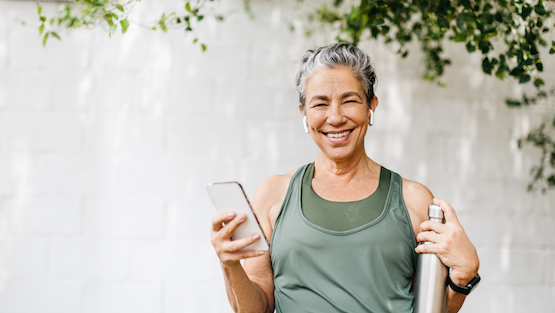Supported Bridge Pose (Setu Bandha Sarvangasana) is one of the most relaxing and nourishing yoga postures we can do.
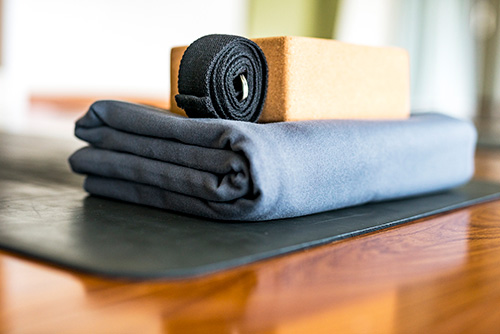
The many benefits of supported Bridge Pose:
- Relieves headaches
- Promotes deep relaxation
- Soothes the nervous system
- Relieves anxiety, depression and irritability
- Improves digestion, respiration and circulation
- Stretches the neck and shoulders
- Reduces “heaviness” in the abdomen and reproductive system
- Balances and tones the kidneys, adrenals, thyroid and parathyroid glands
- Nourishes women’s health at all life stages including during menstruation, pregnancy (unless you feel dizzy lying on your back), all stages of menopause, and the wonderful “wise woman” years post-menopause
This pose is easy to love when your yoga instructor demonstrates and helps you set up for it during class —it feels supportive and comforting to embrace. However, once you’ve come out of the pose and are back out in the world, you might struggle to recreate such a set up or experience on your own.
Well, I have good news for you! There are many variations of this posture, which gives you the opportunity to find exactly which one is best for you and your body.
Optional yoga props:
- Bolster
- Blankets or towels (yoga or regular)
- Blocks
- Strap, scarf or belt
- Mat
- Pillows
- Books
Easy options for Supported Bridge Pose
No matter which props you have when you try to do this pose at home, use these tips to find the right version for you.
1. If you have ALL the props
Facing a wall, sit sideways on a bolster so that your head and shoulders are on one side and your legs are on the other. Gradually lie back so your head and shoulders rest on the floor. Extend your legs and rest your heels on either a block or a folded blanket, with the soles of the feet pressing into the wall. (Before you lie back, you can wrap a belt or strap around your upper thighs to keep the legs from splaying out.) Relax your arms out to the side, in a cactus shape, or place your hands on your belly. Breathe in and out gently. Stay for 5-10 minutes. Gently roll to one side to come out of the posture.
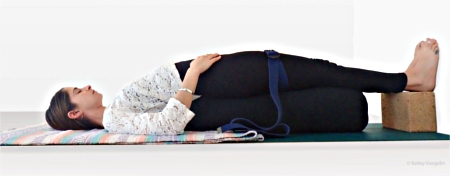
2. If you don’t own a bolster
You can make a bolster by stacking folded blankets on top of each other. (Make sure they feel smooth and even — you don’t want a “princess and the pea” situation here!) You can also roll blankets into the shape of a bolster or cover a pillow with a folded blanket or towel. Once you have your “bolster” made, follow the same steps as above.
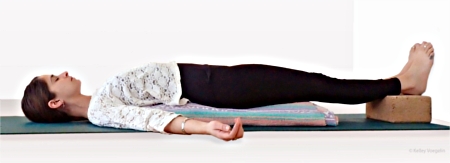
3. If you don’t own a yoga strap
A yoga strap provides stability and containment for your legs. This is helpful if you have discomfort in your lower back because neutral or internally rotated legs widen the sacrum.
If you don’t own a “yoga” strap, use a belt or tie a scarf around the tops of your thighs. You certainly don’t need a strap for this pose and can try simply pressing your feet into the wall to help maintain neutral legs.
4. If you have ONE blanket and TWO yoga blocks
Use the blanket to cover the blocks for cushioning, or slide the edge of the blanket under the base of your skull to support your head and neck.
Sit in the middle of the mat and place one block at its lowest height between your feet. Lie on your back, bend your knees, press into your feet and lift your hips. Slide the second block under your sacrum on its lowest height. Extend your legs forward and place your heels on the first block. You can press the soles of your feet against a wall for more stability. Getting the distance right between the blocks can be tricky. If you measure incorrectly, come up and try again.
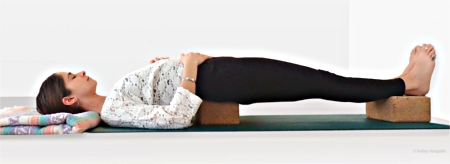
5. If you have TWO yoga blocks or just blankets
Put one block under the sacrum and the other under the heels, as above. If you only have blankets, fold them to give some height and use them in place of the blocks.
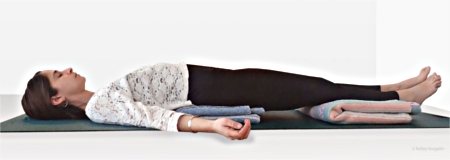
6. If you have ONE yoga block
Sit in the middle of the mat, lie on your back, bend your knees, press into your feet and lift your hips. Slide the block under your sacrum on any height (low, medium or high) that feels okay for your low back. Bend your knees and keep them directly above the ankles, or separate your feet slightly wider so the knees can join easily at your midline.
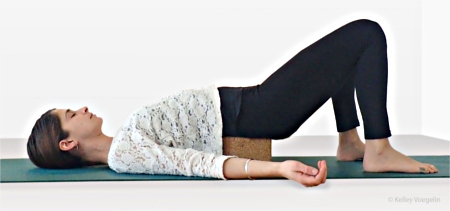
Getting creative when it comes to yoga and props
No blocks at all? Use pillows, folded towels or books to create the shape of a block that you can slide under the sacrum.
No wall to press your feet against? It is completely okay to do any of the above-mentioned options sans wall. The wall makes it simple to give your feet and legs a sense of being contained and keeps them in place. But you can try resting your calves on blocks or blankets if you don’t have a free wall space.
No yoga mat? No biggie! You’ve got a floor, don’t ya? Lie on the carpet or a blanket.
No matter which props you use or the modifications you choose, use these actions to maintain safe alignment in Bridge Pose:
- Tuck the shoulders under your chest (i.e. pull the shoulder blades together) to lift and open the heart space.
- Tuck the tailbone forward to lengthen the lumbar spine.
- Don’t let the legs roll out — keep the thighs neutral or internally rotated.
- Keep the neck long, spacious and relaxed — try not to over-stretch this area.
- Place palms face-up to encourage an open chest, or gently rest the hands on the body to feel grounded and secure.
A yoga practice should aim for availability (with poses that work for your body) and sustainability (you want to keep doing it regularly). Over the course of your life and ever-evolving yoga journey, you may call upon any or all of the many variations of Supported Bridge Pose depending on what your body needs or can do on that given day.
Have fun with the props so you can explore your body and what works for you.
 |
Supported Bridge Pose is great for relieving headaches.
See what other poses Kelley recommends for relief and prevention. |








